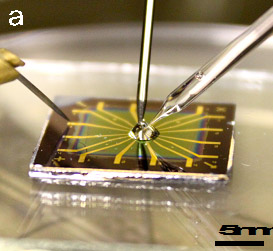
Goldsmiths' Professor of Materials Science
BSc (Eng) Rutgers University
PhD University of Cambridge
2D Materials and Devices
My research interests are in the fundamental studies of atomically thin two-dimensional transition metal dichalcogenides (TMDs). In particular, we study the electronic and electrochemical properties of 2D TMDs. This involves synthesis by chemical exfoliation or chemical vapor deposition, characterization using advanced analytical techniques and fabrication of nanoscale devices. We also study phase transformations in monolayered materials and utilization of phases with disparate properties for catalysis and energy storage.
2D Semiconductors for Transistors
In state of the art short-channel FETs, leakage current leads to power dissipation in the OFF state due poor gate electrostatics. In FETs with 2D semiconductors, charge carriers are confined within atomically thin channels and hence are uniformly influenced by the gate voltage – giving rise to excellent gate electrostatics so that OFF state current is reduced. Contact resistance, however, is a major concern for FETs with 2D semiconductors. The aim of this research is to understand how ultra-clean electrical contacts on 2D semiconductors can be realized and how the work function can be engineered to facilitate both electron and hole injection.
Microelectrochemical cells for catalysis and energy storage
We have pioneered microelectrochemical cells that allow precise identification of catalytically active sites. We can accurately quantify the catalytic activity from edge sites or the basal plane for the hydrogen & oxygen evolution reactions as well as oxygen, CO2 and N2 reduction reactions. We can lithographically pattern devices so that only specific regions of the catalyst material (e.g. edge or basal plane) with well-defined number of atoms are exposed to the electrolyte. Thus, we can accurately quantify the activity of edge sites or the basal plane and because we know the exact area of the patterned electrocatalytically active region, it is possible to precisely extract fundamental parameters such as the exchange current density, the turnover frequency, and Tafel slopes for atomic active sites. We can only use this technique to make micro-batteries on a chip to study electro-chemo-mechanical changes that occur on the electrodes during charging and discharging.
Metallic 2D Materials for Electrocatalytic Reduction of CO2 and N2
Metallic 2D materials have recently emerged as a class of potentially inexpensive catalysts with enhanced activity and increased stability. However, their overall activity relative to state-of-the art noble metal catalysts is limited by slower reaction kinetics and high charge transfer resistance. Our group’s seminal work several years ago revealed that these factors can be mitigated by metallic 2D materials. In subsequent works, we have shown that increasing the metallic phase concentration and lowering the electrical resistance between the support and catalyst nanoparticles can lead to substantial improvement in catalytic performance. An example of this is metallic NbS2 where it is possible to achieve very high current densities (several Amps-cm-2) in proof of concept electrolyzer devices for electrocatalytically generating hydrogen. We expect metallic nanosheets to be exceptionally good catalysts for the HER or CO2RR and N2RR. We are therefore investigating the properties of 2D materials towards CO2 reduction and the hydrogen evolution reactions to identify the best candidates for both reactions.
|
Photograph of a lithographically patterned microelectrochemical cell used to measure the catalytic activity of 2D TMD materials. |
 |
- Yan Wang, Jong Chan Kim, Ryan J Wu, Jenny Martinez, Xiuju Song, Jieun Yang, Fang Zhao, Andre Mkhoyan, Hu Young Jeong, Manish Chhowalla "Van der Waals contacts between three-dimensional metals and two-dimensional semiconductors" Nature 568, 70–74 (2019)
-
Damien Voiry, Hyeon Suk Shin, Kian Ping Loh, Manish Chhowalla "Low-dimensional catalysts for hydrogen evolution and CO2 reduction" Nature Reviews Chemistry 2: 0105 (2018)
-
Heejun Yang, Sung Wng Kim, Manish Chhowalla and Young Hee Lee "Structural and quantum-state phase transitions in van der Waals layered materials" Nature Physics 13 931-937 (2017)
-
Manish Chhowalla, Debdeep Jena, and Hua Zhang "Two-dimensional semiconductors for transistors" Nature Reviews | Materials 1 16052 (2016)
-
Damien Voiry, Raymond Fullon, Jieun Yang, Cecilia de Carvalho Castro e Silva, Rajesh Kappera, Ibrahim Bozkurt, Daniel Kaplan, Maureen J. Lagos, Philip E. Batson, Gautam Gupta, Aditya D. Mohite, Liang Dong, Dequan Er, Vivek B. Shenoy, Tewodros Asefa, and Manish Chhowalla "The role of electronic coupling between substrate and 2D MoS2 nanosheets in electrocatalytic production of hydrogen" Nature Materials, 15, 1003 (2016)
